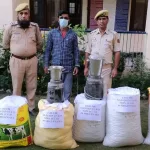Srinagar, Feb 20: Jammu and Kashmir is grappling with a prolonged dry spell, attributed to both global climate change and the extensive deforestation triggered by infrastructure projects. Over the past several decades, the rampant felling of trees for highways and other developmental initiatives has dramatically altered the region’s landscape, further exacerbating its environmental challenges, says officials.
A senior Forest Department official told Rising Kashmir that the ongoing construction of the four-lane Srinagar-Baramulla highway and the double-lane Baramulla-Uri highway has led to the felling of over 1,700 trees. “From Narbal to Mirgund alone, 1,509 poplar trees, 38 mulberry trees, and two dozen chinar trees have been felled. Similarly, in the Delina-Uri section, countless trees are set to be removed,” the official added.
In addition, over 21,000 trees are being chopped down for the construction of the 670 km Delhi-Amritsar-Katra Expressway by the National Highways Authority of India (NHAI). An RTI response from Jammu-based activist Raman Sharma reveals that 21,483 trees will be cut along the Kunjwani-Sidhra and Sidhra-Ban Toll sections of the Jammu-Katra Expressway. The breakdown shows that 11,946 trees will be felled in the Jammu Forest Division along the 13.4 km Kunjwani-Sidhra section, 1,781 in the 15.3 km Sidhra-Ban Toll section, and 7,756 along the 15.6 km Domel-Katra stretch.
The tree felling, supervised by the Jammu and Kashmir Forest Department, has already seen 8,402 trees cut, with 13,332 more slated for removal in a phased manner. Additionally, over 716 kanals (36.25 hectares) of forest land in the Jammu and Reasi Forest divisions are being diverted for the expressway construction.
The ecological damage extends beyond road projects. The construction of the new Jammu and Kashmir High Court complex in Raika-Bahu, a critical green belt known as the “Lungs of Jammu,” will lead to the destruction of approximately 38,000 trees over 40 hectares. Similarly, during the expansion of the Srinagar-Qazigund Expressway, 75 chinar trees, including 58 in Pulwama and 17 in Anantnag, were felled. RTI activist M.M. Shuja revealed that the government collected Rs 28.17 lakh from the tree felling, which has been deposited in the treasury.
In response to the alarming deforestation, Principal Chief Conservator of Forests (PCCF) and Head of Forest Force (HoFF) Suresh Kumar Gupta told Rising Kashmir that the Forest Department is working towards planting 1.5 crore trees by the end of March through winter and monsoon plantation drives. “By the end of January 2025, we have already planted 82 lakh trees,” Gupta said.
The National Highways Authority of India (NHAI) has also taken steps to restore greenery along stabilized highway stretches. “From Qazigund to Srinagar, we have tendered the work to a private firm, while in areas like the Jammu Ring Road, our department is assisting with the replantation process,” Gupta added.
“Chief Secretary Atal Dulloo has reviewed the department’s work, and we are striving to meet our target within the given timeframe. By the end of January 2025, we have already planted 82 lakh trees,” Gupta said.
Meanwhile environmental activists, however, argue that afforestation efforts are not sufficient to counteract the large-scale deforestation and climate change impacts.
Suhail Farooq, an environmentalist, stressed that changing weather patterns in Kashmir, marked by dry winters and extreme summers, result from both global climate change and regional deforestation.
“The loss of forest cover over the past several decades has disrupted temperature regulation and precipitation cycles. Forests play a crucial role in maintaining climate stability by absorbing carbon dioxide and regulating the water cycle,” he said.
Dr. Sarfaraz Ahmad, an environmental researcher at Central University Jammu also pointed out that Jammu and Kashmir has been witnessing erratic weather patterns for nearly three decades, resulting in drought-like conditions, flash floods, and windstorms.
“In 2014, devastating floods hit the region due to incessant rains and cloudbursts. Snowless winters, Rising temperatures have accelerated glacier retreat in the Kashmir Himalayas, with the Kolahoi Glacier, the largest in the Jhelum Basin, shrinking at an alarming rate due to global warming and extreme pollution,” he said.
Other glaciers, including Thajiwas, Hoksar, Nehnar, Shishram, and those around Harmukh, are also rapidly melting.
Dr. Safaraz also warned that Kashmir’s changing weather patterns, particularly prolonged dry spells, are a stark reminder of the broader impacts of climate change.
“Addressing these challenges requires a multi-faceted approach that combines environmental conservation, sustainable development, and community engagement,” he added.
Presently, Jammu and Kashmir has a total forest area of 20,230 square kilometers, making up roughly 19.95% of the region’s total geographical area of 101,387 square kilometers. The forested land is divided into 2,551 square kilometers of reserved forests, 17,643 square kilometers of protected forests, and 36 square kilometers of unclassified forests.
Regarding cutting of trees along the highways in J&K, NHAI Spokesman said that they are committed to ensuring that all completed highways undergo extensive plantation drives to restore greenery and mitigate environmental damage.
“ Our objective is to not only compensate for the lost green cover but also enhance the ecological balance along these roads. Large-scale afforestation initiatives are being implemented, focusing on native and fast-growing species to provide shade, reduce air pollution, and prevent soil erosion,” he said.
The spokesman said that they are working closely with environmental agencies and local bodies to ensure that infrastructure growth and environmental preservation go hand in hand.








